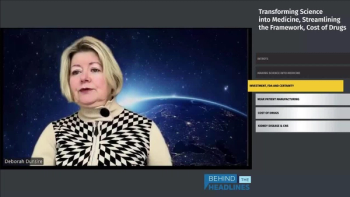
What Pharma Manufacturers Need to Know About US Trade Policy Changes
Tariffs on APIs and finished drugs could take effect as early as August 1, with accelerated investigations raising urgency for supply chain planning.
In this first segment of a multi-part interview, Jason Waite, international trade expert at Alston & Bird, outlines how recent United States tariff activity could significantly impact pharmaceutical manufacturers. He explains that the Trump administration has used the International Emergency Economic Powers Act to implement “reciprocal tariffs,” which apply broadly to imported goods, including drug ingredients and finished medicines. Although a federal court recently ruled these tariffs exceed presidential authority, enforcement is on hold pending appeal, with oral arguments scheduled for July 31.
Waite also details the emergence of “sectoral tariffs” under Section 232 of the Trade Expansion Act. These target specific products—including pharmaceuticals, APIs, and medical countermeasures—on national security grounds. The public comment period for pharmaceutical-related tariffs has closed, and decisions could follow as early as August 1. Unlike prior Section 232 actions, current investigations are proceeding on an accelerated timeline, raising concerns about trade disruptions in critical supply chains. Waite notes that high tariff rates have already been assigned to key US trading partners, including the EU, Canada, and Mexico, adding further uncertainty. For pharmaceutical manufacturers, the implications span sourcing, cost structures, and compliance readiness amid a rapidly shifting trade policy environment.
Check out the three other segments of this interview series!
- Part 2 -
Tariffs & Trade Policy: What to Watch for, Cost Impacts, and Supply Chain Strategies - Part 3 -
Trade Policy Shifts: Compliance and Cost Strategies for Pharma - Part 3 -
How Pharma Can Build Resilient Supply Chains Amid Trade and Tariff Shifts
About the Interviewee
For over 25 years, Jason Waite has advised clients on all regulatory aspects of international trade and investment, including customs and trade agreements, export controls and sanctions, and related policy matters. Jason conducts internal investigations and compliance self-assessments, develops internal trade compliance and training programs, represents clients in audits and origin verifications, and guides clients through voluntary disclosures of actual and potential import and export violations. Jason has significant experience representing clients that are the subject of government investigations involving alleged violations of the export, import, and economic sanctions regulations. In transactional and strategic planning matters, Jason conducts international trade compliance due diligence, negotiates trade compliance responsibilities among parties to transactions, and develops supply chain optimization and global customs planning strategies. He regularly advocates before agencies in Washington for favorable advance rulings, advisory opinions, and commodity jurisdiction and classification determinations, and handles complex export licensing matters.
He is a frequent speaker at seminars and conferences on international trade topics and has been recognized in Chambers USA, Chambers Global, and The Best Lawyers in America®.
Transcript
*Editor’s Note: This transcript is a direct, unedited rendering of the original audio/video content. It may contain errors, informal language, or omissions as spoken in the original recording.
It could have substantial implications on the import and export of all those drug manufacturing items, ingredients, as well as finished medicines. Why don't we step back for a second and just put this in context. Much of the tariff activity that's occurred so far this year has been the implementation of the president's reciprocal tariffs.
These tariffs have been imposed under the authority of the International Emergency Economic Powers Act. The court of international trade held just a couple months ago that these tariffs are illegal because the president exceeded his authority under that act, but that decision is stayed pending the appeal, which is now in the Court of Appeals for the federal circuit.
Oral arguments are scheduled there for July 31st. The reciprocal tariffs started on Liberation Day. That was 10%, and then there were higher country- specific tariffs that were announced, but then paused for 90 days, and then they've recently been pushed out again to August 1st. In recent weeks, the news that you've been seeing is about the president's tariff letters that are being sent out.
I think he's hit about 25 countries so far with tariff letters that, report to unilaterally established the tariff rate applicable to goods from those countries. The latest letters were a little more than a week ago, that Canada got a 35% rate. Mexico got a 30% rate, and the European Union got a 30% rate.
Particularly significant because these are such major trading partners of the United States. Meanwhile, the administration continues to try to reach agreements with trading partners and has announced agreements or frameworks with the UK, Vietnam, and Indonesia, India, the EU, Japan, South Korea, Mexico, Canada.
These are countries that are understood to be continuing to negotiate with that August 1st deadline approaching. And those tariff letters hanging in the balance. But in addition to these reciprocal tariffs that really threatened to address, to affect all goods from all countries, right?
In addition to these tariffs, the president has imposed what's now being referred to as sectoral tariffs against specific products and for this, he uses section 2 3 2 of the Trade Expansion Act of 1962. These tariffs have so far been used against steel, aluminum, automobiles and automotive parts, and they're expected, or there are pending investigations going on that are expected to result in these sectoral tariffs against copper, timber and lumber, semiconductors, trucks, critical minerals, aircraft and jet engines, polysilicon, unmanned aircraft systems, and yes, pharmaceutical products and their ingredients.
The president has said tariffs on copper will take effect August 1 with tariffs on pharmaceuticals and probably semiconductors expected to be next. It was in April that the administration initiated an investigation to determine the effects on national security of imports of pharmaceuticals and pharmaceutical ingredients, including finished drug products, medical countermeasures, APIs, key starting materials, and derivative products of those items. Under Section 2 3 2, the Bureau of Industry and Security within the Department of Commerce conducts an investigation that includes a public comment process, which is already closed with respect to pharmaceuticals. And if the BIS investigation concludes that excessive foreign imports of the target product are a threat to national security, the president may levy tariffs on those imports.
And the administration has been moving these investigations very quickly. By comparison in the first Trump term, the investigations against steel and aluminum, which began in the first Trump term, took close to a year. I think it was 10 months from the time the investigation began until the time tariffs were imposed.
But they're moving faster on copper. They say they're ready to move faster on semiconductors and pharmaceuticals. So they've now gotten this down to what looks to be about four months of investigation before tariffs can be applied as a result of this investigation. And we think these tariffs on the pharmaceutical products could be as soon as August 1.
Newsletter
Get the essential updates shaping the future of pharma manufacturing and compliance—subscribe today to Pharmaceutical Technology and never miss a breakthrough.




